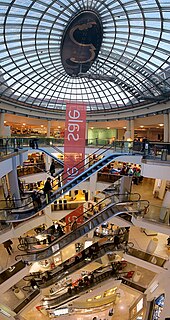Skylight

The skylight (in Bavaria and Austria the skylight , in Switzerland the skylight ) is a light opening in the ceiling that supplies the interior with daylight . In contrast to the skylight , a skylight is not designed for a view of the surroundings, but is limited to the function of lighting and, if necessary, ventilation .
In addition to the component, the term skylight can also generally refer to the incidence of light from above in a building. In the case of rail vehicles, a roof structure with a vertical ribbon of windows is called a skylight structure .
Use and construction methods
Skylights are used in larger halls or halls or in rooms that are inside the building and therefore cannot have window openings in the wall.
If a room does not end with a horizontal ceiling, but with sloping ceilings, a skylight can be used. The difference between large skylights and glass roofs such as roofed courtyards is fluid. The shed roof was developed for industrial architecture in order to provide large halls with daylight .
In modern house construction, industrially manufactured plastic skylights are used. They consist of an upstand that is mounted on the top of the roof and an outwardly curved, transparent or milky dome made of acrylic glass or polycarbonate . Commercially available dimensions range from 0.30 m × 0.30 m to 2.50 m × 2.50 m. Such skylights can be equipped with an electric motor for opening.
Skylights are often used in agricultural buildings for inexpensive lighting.
If the ceiling is not directly adjacent to the roof cladding , a light tube can be used to direct daylight into the room.
history
Early architectural-historical examples of the lighting principle of the skylight can be found in the form of ceiling openings in Egyptian temples. The Compluvium , the ceiling opening of the atrium in ancient Roman architecture, also had the function of lighting in addition to collecting rainwater. The open opaion at the top of a dome can be cited as a special form .
With certain types of construction or components, the light also comes in from above through vertical windows: for example in basilicas through the windows of the upper aisle or a lantern tower , in domed buildings through the wreaths of a lantern or a drum .
Glazed horizontal skylights are often found in the architecture of Classicism , Historicism and Art Nouveau , later in a similar form. The glass panes are usually built into a metal roof structure, which is shaped as a hipped roof or tent roof . Skylights of this type are usually designed in such a way that they are covered by an attic or by the surrounding roofs in the external view of the building and only appear as an element of the interior design .
Skylight on railroad cars
In the case of railroad cars , an additional narrow vertical ribbon of windows can be arranged in the roof area. This type of construction is referred to as a skylight structure or lantern roof , but is rarely found today. Examples of such vehicles from the early days of the railway are:
- the saloon car Salon 3 sa 85 from the Saxon court train
- the three-axle Bavarian compartment car B3 Bay 90
Web links
Individual evidence
- ↑ Hans Koepf , Günther Binding : Picture Dictionary of Architecture (= Kröner's pocket edition . Volume 194). 4th, revised edition. Kröner, Stuttgart 2005, ISBN 3-520-19404-X , p. 343.


